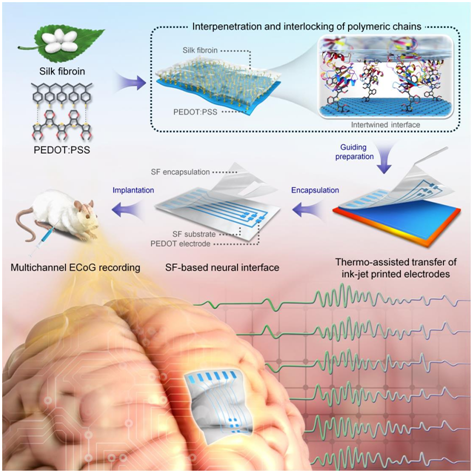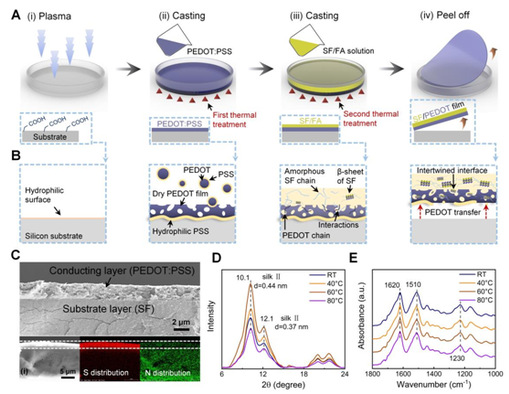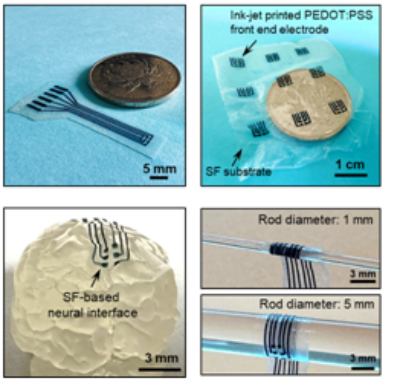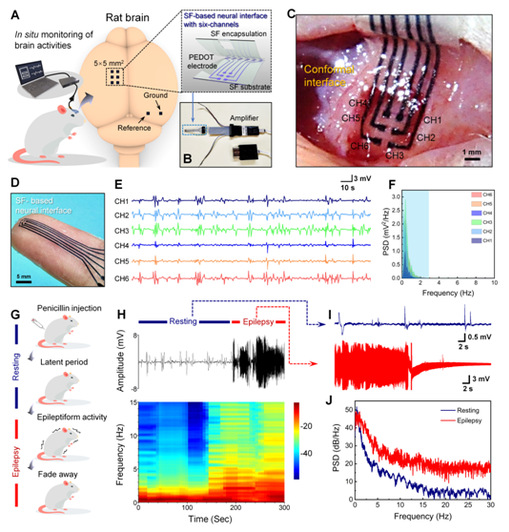With the continuous development of brain-machine interface technology, the sci-fi scenario of controlling external devices with thoughts is gradually becoming a reality. Recently, the State Key Laboratory for Modification of Chemical Fibers and Polymer Materials at Donghua University, in collaboration with Shanghai Sixth People’s Hospital Affiliated to Shanghai Jiao Tong University School of Medicine, has developed a thermo-assisted pattern transfer technique that effectively regulates the molecular interpenetrating interface of silk fibroin (SF) and poly(3,4-ethylenedioxythiophene) (PEDOT). This technique has produced a non-transient SF flexible neural interface with outstanding conformality and durability, successfully capturing rat cortical electrocorticography (ECoG) signals with higher accuracy and lower noise ratio, while maintaining good biocompatibility. This advancement provides potential for long-term EEG monitoring, neuropathological research, and human-machine interaction, and holds general applicability in the design of other SF-based implantable electronic devices.
The related research findings, titled “Flexible Neural Interface from Non-transient Silk Fibroin with Outstanding Conformality, Biocompatibility and Bioelectric Conductivity”, have been published in Advanced Materials. The first author is Hu Zhanao, a doctoral student at Donghua University’s State Key Laboratory for Modification of Chemical Fibers and Polymer Materials and the College of Materials Science and Engineering. Liang Yuqing, a doctoral student at Shanghai Jiao Tong University School of Medicine, is the co-first author. The corresponding authors are Researcher Zhang Yaopeng and Associate Researcher Yao Xiang from Donghua University, and Chief Neurosurgeon Chen Hao from Shanghai Sixth People’s Hospital Affiliated to Shanghai Jiao Tong University School of Medicine.

(Overview diagram of research concept and technology)
As a key component of brain-machine interface technology, the performance of neural interface devices largely determines the quality of the electrophysiological signals collected. SF film materials, with their excellent processability and low immunogenicity, can overcome adverse effects such as excessive mechanical rigidity and poor biocompatibility, making them ideal materials for constructing biomass flexible neural interface devices.
In this study, researchers at Donghua University prepared a higher molecular weight SF solution based on a formic acid-calcium chloride system. The presence of formic acid facilitated the interpenetration and entanglement between SF long chains and PEDOT molecules. With the assistance of temperature, the SF solution gradually solidified (recrystallized), firmly locking the infiltrated PEDOT molecules within the SF layer, forming an SF/PEDOT interwoven interface. This processing method endowed the resulting SF/PEDOT material with intrinsic non-transient properties, and its interwoven interface greatly ensured the high conductivity of the PEDOT conductive layer and its tolerance in a wet environment, laying a theoretical foundation for the subsequent preparation of non-transient SF flexible neural interfaces.

(SF/PEDOT films and related characterization based on thermo-assisted pattern transfer technology)
Using “thermo-assisted pattern transfer technology”, researchers successfully transferred inkjet-printed PEDOT electrodes onto an SF flexible substrate, creating a non-transient SF flexible neural interface with six-channel electrodes, and collected ECoG signals from the cortical surface of anesthetized rats. Compared to control neural electrodes (commercial polyimide type), this electrode demonstrated higher accuracy and a better signal-to-noise ratio. “Compared to existing SF-based neural electrode/interface materials, our SF flexible neural interface shows significant advantages in conformality, water stability, and smaller electrode size,” said Hu Zhanao.
Experimental results indicate that drug-induced epileptic seizures in rats are intermittent, cycling through latency (or resting), seizure, and remission phases approximately every half hour, rather than being in a prolonged seizure phase as commonly believed. This confirms that the non-transient SF flexible neural interface can differentiate various brain waves in epileptic states in rats.

(SF flexible neural interface with outstanding surface conformality)

(Function verification of non-transient SF flexible neural interface)
Regarding the critical issue of biocompatibility of the non-transient SF flexible neural interface, the research team conducted focused evaluations on postoperative animal survival, immune response, and blood inflammation factor levels. The results indicate that, benefiting from the good flexibility, conformality, and low immunogenicity of the SF neural interface, rats can recover normal physiological functions shortly after surgery, with no significant abrasions on the cortical surface, and low expression levels of inflammatory factors in the blood, which will be beneficial for future clinical application research.
Moving forward, the team will focus on developing silk fibroin flexible neural interfaces with high-density channels, wireless transmission of brain signals, and data analysis, potentially providing references for the development of next-generation neuro-disease diagnosis and treatment technologies and brain-machine interface technologies.
Paper link: doi.org/10.1002/adma.202410007